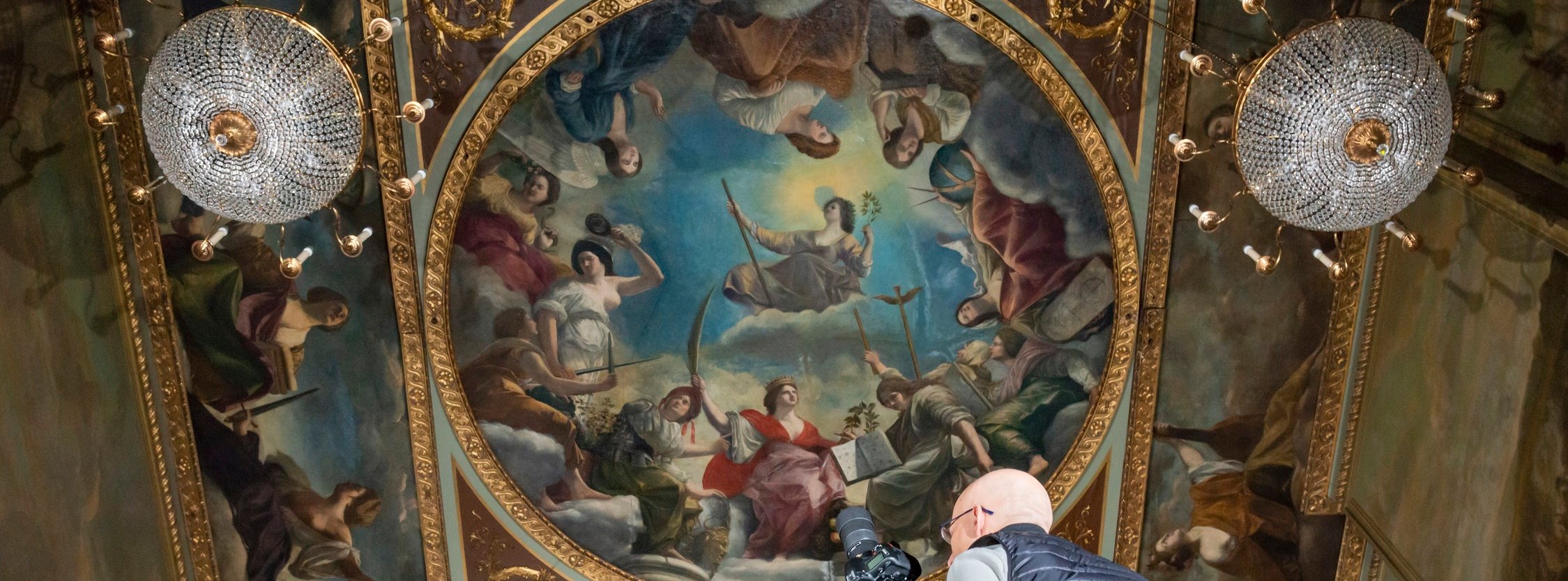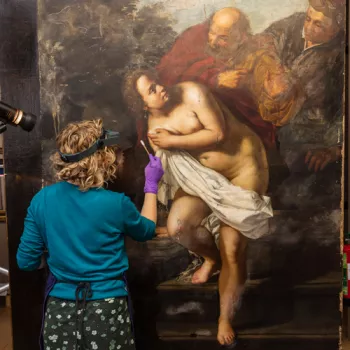The Marlborough House ceiling by Orazio and Artemisia Gentileschi
An Allegory of Peace and the Arts

This ceiling, the last and most significant commission of the Florentine artist Orazio Gentileschi, was originally created for the 'House of Delight' of Queen Henrietta Maria, wife of Charles I. Now better known as the Queen's House, Greenwich, this was the first building in a classical style in England. Designed by the architect, Inigo Jones, for Queen Anne of Denmark, and completed in about 1636 for Henrietta Maria. Jones also designed the marble floor of the Great Hall to reflect the compartments of the ceiling.
The ceiling was probably installed at the end of 1638 but there would have been little chance for the Queen to enjoy it because in 1642 she fled the country for France on the outbreak of the Civil War. The escapist world of the ceiling and court masques ended with the execution of Charles I on 30 January 1649.
Early in the next century Queen Anne granted the ceiling to her favourite, Sarah, Duchess of Marlborough, for her new residence Marlborough House on Pall Mall, now the Commonwealth Secretariat, where the ceiling remains. It was probably installed there as the ceiling of the Blenheim Saloon in 1711. Unfortunately the ceiling was reduced in size to fit the smaller space by cutting out sections of the central roundel and trimming the outer canvases. In its history the ceiling has suffered substantial paint loss, probably the result of damp, and has had several campaigns of restoration, with much repainting. Viewers seeing the ceiling in its original pristine state would have been transported to an ethereal world filled with light and heavenly figures, some with powerful physiques and all painted in rich colours with such clarity and delicacy.
Orazio Gentileschi
Gentileschi trained as a goldsmith before turning to painting. He had a virtuoso ability to meticulously and sensitively capture rich colours and recreate textures of fabrics in a silvery light. In about 1600 Orazio encountered the realism and dramatic use of light of Caravaggio’s paintings in Rome. This transformed Orazio’s work, though his exquisitely refined style remained a constant throughout his life, and always appealed to his aristocratic clientele across Europe.
From his accession in 1625 until the outbreak of civil war in 1642, Charles I and his Stuart courtiers amassed an extraordinary collection of art. Charles I particularly liked Italian art, both Old Masters and contemporary, and was keen to entice Italian artists to come to work for him. Gentileschi was brought to London in 1626 by the Duke of Buckingham, having previously worked for the Queen’s mother, Marie de' Medici, in Paris.
It was Henrietta Maria rather than Charles I who was his most important patron, gathering three large history paintings by Orazio to her Italianate ‘House of Delight’ at Greenwich, one of which, Joseph and Potiphar’s Wife (RCIN 405477) is still in the Royal Collection, and commissioning the ceiling, Gentileschi’s last and most significant commission. Learn more about Joseph and Potiphar’s Wife in Collection Online.
Inigo Jones must have devised the iconography of the ceiling with Orazio, using the popular handbook for allegorical representations, Cesare Ripa’s Iconologia. Many of the personifications also appear in the dramatic spectacles or masques which were performed at court for which Jones provided costume designs and stage sets. Two of these celebrated Peace and all of them, like the ceiling, were intended to glorify the King and Queen through allegory. The staged quality of the figures in the ceiling and Orazio’s sophisticated, but artificial court style contrasts with the more dynamic, down-to-earth energy of Orazio’s great rival, Peter Paul Rubens, whose great ceiling glorifying King James I had been installed in the Banqueting House at Whitehall by March 1636.
Study the ceiling in more depth
This interactive was produced as part of the Google Cultural Institute project in support of the National Gallery exhibition 'Artemisia' to which a number of Royal Collection works were loaned.
Learn more about Artemisia on the Google Arts & Culture website.









